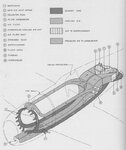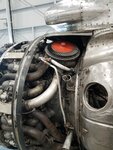Still doesn't make sense to me; this engine is available to many aircraft; yet the P-47 utilizes this system of duct work and turbines to capture engine exhaust, cool and convert into supercharged air for the engine intake.
There are no engine exhausts headers on the the P-47 sticking out the side of the airframe, the exhaust is ducted to the turbo-supercharger, then there are controllable 'waste gates' of the turbo-supercharger.
The exhaust goes from the engine to the turbo, then exhausts from under the turbo well behind the wings. The waste gates are used to regulate the exhaust pressure to the turbo. The two flaps behind the waste gates are oil cooler exits.


